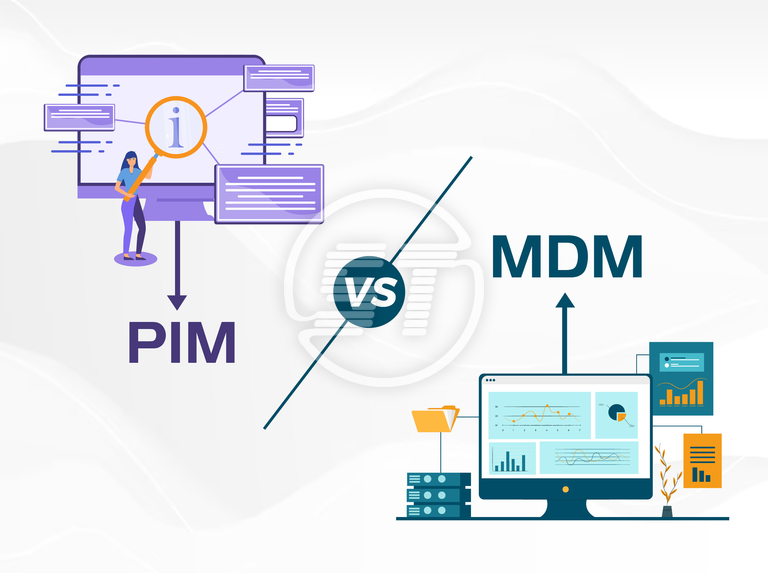The new digital era is all about possibilities. There is scope for businesses to scale and grow like never before. Certainly, technology has given wings to businesses to rapidly increase their sales and profits. As these online businesses are growing, they need a more robust structure to maintain their important data across the platforms.
To store colossal business data, will you prefer to rely on older spreadsheets or some modern and sturdy automated system?
Automated systems such as PIM, MDM, etc. offer error-free and quick data collection at a single hub and help reuse the stored data as well. PIM and MDM both assist organizations in data management but in distinct ways.
Want to know more about these two prominent data-handling tools? Read the PIM vs MDM article and get insights on each concept.
YOU MAY ALSO LIKE: Pimcore 6 to Pimcore 10
PIM & MDM – Overview
PIM (Product Information Management)
It is software that is meant to manage and organize every sort of product information and help marketing and merchandising teams. In a PIM system, you can easily add and update product data from any location and it gets reflected across the business locations.
MDM (Master Data Management)
Whereas Master data management stores and handles organizations’ all-important data in one place. Products, customers, employees, suppliers, assets, and all other crucial data can be stored in their entirety.
PIM vs MDM – Differences!
Both PIM and MDM work effectively to handle organizational data but they have significant differences as well. PIM manages product information and MDM handles entire business data along with product information.
PIM system enhances data quality and accuracy. It mitigates work redundancy by storing data in a single place. Since updated product information stays in place, it increases the operational productivity of teams. Product Information Management helps maintain brand identity by providing accurate product information and hence reduces product returns and increases overall conversions.
It collects and centralizes product data from sources like ERPs, databases, media systems, supplier portals, etc. Furthermore, the data can be sanitized as per business requirements and integrated into catalogues. The completely enriched data can be distributed to all sales channels such as ecommerce platforms, AI chatbots, marketplaces, mobile applications, social networks, etc.
PIM also creates an appropriate data model for organizations, which helps them to scale and grow at faster pace. It develops business-centric workflows and makes user interfaces for data import and export for various resources. Since it has API-led connectivity, it helps integrate all existing systems smoothly.
MDM helps organizations to decrease the complexity that normally occurs during expansion and globalization. It provides consistent data about each facet of business, which ultimately improves business operations. Furthermore, it allows you to edit and add data at one location and reflects changes at all other places. You get cleaner and more consistent data for analysis. Moreover, it maintains compliance needs as well.
It can be either single-domain or multi-domain. If you choose multi-domain MDM, it includes all data domains of organizations that you’ve prioritized for data management. Thus, it becomes a time-intensive process and requires some specific and significant resources to implement it in your system.
MDM also has different use cases (operational and analytical) and various styles (Consolidation, Registry, Co-existence, Centralized) to create distinct data strategies.
One more significant difference between PIM and MDM is that MDM implementation is way more expensive them PIM.
YOU MAY ALSO LIKE: Headless CMS Vs Traditional CMS
Benefits of using PIM and MDM
So, PIM helps centralize product data and improves data silos. The scattered data, which provides no quality to the system, is being sanitized and organized by PIM. Though it is completely dependent on your business vision and objectives, it is suggested that small and medium organizations should use PIM to streamline their business.
On the other hand, MDM is the best option to organize each useful backend data. It inculcates operational excellence in business by providing data control. Though it is an expensive option, but it helps with solving all major problems related to every nook and corner of organizational operations.
What else do you need, if an automated solution can help you with solving data issues? Currently, businesses are preferring to run their operations using such efficient data management tools.
So, use either PIM or MDM to leverage its benefits for your organization. But, before you choose anyone (PIM or MDM) for your business, brainstorm and understand what your use case is.
PIM and MDM Together – Combine Them for Good
Do you think, your business might need both PIM and MDM together?
Is it possible that you implement both solutions to build an impeccable system?
Well, it is no one size fits all concept. You choose as per your business unique demands; however, PIM and MDM together are a beyond-excellence option. Because together they will work to create a sorted and well-planned system where you can execute all business operations without many complications.
PIM will optimize product data across customer touchpoints and MDM strategies will look after other facets of business and analyse them regularly. If you are facing difficulty in handling business data and making data-driven decisions, don’t get confused more and implement both PIM and MDM. They will help you build a unified brand.
Nevertheless, even if you implement them efficiently, there can be some challenges still left such as
How to create an API-driven IT structure?
How to make the process of data quality improvement faster?
Uniformity of data in external appearance, data distribution to customers, and most importantly, implementation and execution of both solutions at a lower cost.
But anyways, every coin has two sides. If one side is full of benefits, another side can be managed.
YOU MAY ALSO LIKE: Reason You Need PIM For Your Business
Which is an apt solution for your business?
PIM and MDM both solutions handle and organize a crucial set of business data and create a single source of information. In a nutshell, they create a centralized source of truth to provide a sturdy system to keep everyone on the same page and run all business operations smoothly.
But how will you decide, which solution is appropriate for your organization?
So, you can think of some important facets such as if you wish to increase sales, if enhancing product SKUs is your goal, or if your plan is to add more business channels to grow your business reach, PIM will be the perfect option for you. Because it is a business-centric marketing tool that is meant to create a faster and more robust data management system and eventually helps skyrocket business ROI.
PIM also plays an efficient connector and connects easily with e-commerce, mobile applications, and POS systems and improves overall marketing and sales. These channels are crucial for a business since they are the main sources that consume data heavily.
However, if your business needs entire data domains organization such as financial, customers, employees, along with product data across the locations and resources and time are not a concern for you, then nothing else but MDM will work best for your business.
And there is one more option, which is using PIM and MDM together for more accuracy in your entire business domains.
Looking to leverage Pimcore MDM but not sure where to start? We are PIMCORE silver partner and our team of certified Pimcore developers provides comprehensive Pimcore development services, covering PIM, MDM, DAM, CMS, design, multi-channel ecommerce, integration, maintenance, and support for SMEs, large businesses, international organizations, and web development agencies. Contact us by filling out the form or emailing hello@skynettechnologies.com to learn more about our services.


